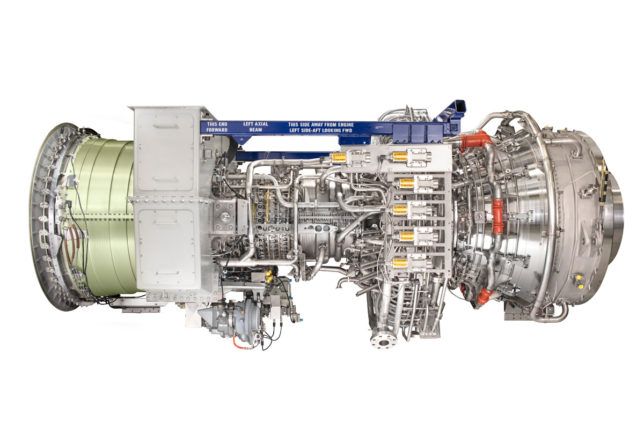GE bets on aeroderivatives

Caption: LM6000 PF+
Martin O’Neill, General Manager of Aeroderivative Gas Turbine Services for GE’s Power Services business, discusses the company’s plans for its aeroderivative fleet.
How confident are you of growth in the aeroderivative market?
According to a 2016 study by Technavio, the global aeroderivative gas turbine industry is expected to grow at an annual rate of nearly 5% between 2016 and 2020. Aeroderivatives are likely to become the go-to technology to provide balancing services for renewable energy. These mounting power imbalances are increasingly forcing conventional generators to operate in a more flexible manner, ramping more frequently to balance intermittent renewables and provide grid-firming services. Given this crucial role in power infrastructure, downtime can be expensive, and it’s critically important that operators have plans in place to ensure continued operations and minimal lost time for maintenance and repairs.
How is GE investing in aeroderivatives?
$200 million is being spent to develop new technology and enhance our service capabilities. GE is investing in its Houston Service Center with an overall maintenance overhaul. We have added approximately 40 jobs, and will continue to improve the work environment, tools, fixtures and implement new IT systems. We have added digital capabilities and processes to service more than the current 500 engines and modules per year. This is more volume than any other GE repair center.
On the technology side, GE is continually upgrading the reliability and availability of the existing fleet, as well as repairs for the fleet. We also have some new units, including the LM6000-PF+, the next generation of the LM2500, which is in development, and the recently launched LM9000 aeroderivative.
What about overall strategic direction?
The three pillars of our strategic direction are decentralization, digitization, and decarbonization. Decentralization is an area where aeroderivatives have been on the forefront in distributed generation applications under 100 MW, such as microgrids, combined heat and power (CHP), and others where the point of power generation is close to the point of consumption. Aeroderivatives were designed and built for these applications and have been doing it for 40 years. Distributed generation is a significant part of the energy mix and where a large portion of our current fleet is in service.
How are you addressing decarbonization?
Decarbonization is about adding more solar and wind onto the grid to reduce the emissions footprint. Aeroderivatives are a critical component for renewables balancing. With quick start times under 10 minutes, they can cycle quickly without maintenance penalties and are therefore best suited for renewables balancing. In addition, Dry Low Emissions (DLE) technology, which does not use water, further reduces emissions from these gas turbines.
How is digitization being applied to aeroderivatives?
GE’s Asset Performance Management (APM) software provides aeroderivatives with data analytics to help predict and eliminate unplanned downtime and improve plant reliability and availability. GE provided a digital upgrade for an Italian petrochemical company’s aeroderivative gas turbine. GE’s LM2500+G4 aeroderivative gas turbine and generator will be upgraded with digital technology enhancements. The project marks the first digital implementation of an aeroderivative unit in Europe. APM software is expected to increase the availability of the power plant up to 97%.
What do you see as the primary role of the LMS100?
The LMS100 has a fleet of over 60 operating units (with another 13 being commissioned during 2018–2019). The majority are in North America, and those units are primarily being utilized to provide grid-firming for grids highly penetrated by renewables. As renewables grow around the globe, we believe the LMS100 will continue to be a good fit for much needed grid reliability with its ability to start up and provide 120 MW of power per unit within eight minutes, as well as high simple-cycle full-load and part-load efficiency.
What are your plans for the LM6000 and LM2500?
The LM6000 and LM2500 have greater than 2,500 gas turbines in service with a combined operating experience of over 130 million operating hours. Continued investment in these machines will improve product performance and flexibility. The original LM6000PA configuration was rated at 42 MW. Upgrades resulting in the LM6000PF+ have boosted that to 56 MW at 42% simple cycle efficiency. The first PF+ reached commercial operation earlier this year. The LM2500 platform was originally rated at 22 MW and that has grown to 34 MW in the LM2500+ G4 with 38% efficiency. The TM2500 mobile gas turbine utilizes the same LM2500 gas turbine technology and is the fastest growing aero fleet for GE.
What is a cross-fleet repower?
The replacement of an entire engine is known as repowering, while upgrading is the replacement of individual components within the engine. The time taken to replace a unit is a critical factor. Cross-fleet comes into play where there is an existing other-OEM gas turbine running. Typically, these are older technologies with low efficiency and high emissions. A cross-fleet repower removes the other-OEM turbine and repurposes the plant with an aeroderivative unit. This creates greater output, better efficiency, and lower emissions. This allows older plants to become more economically viable. GE can use both new and refurbished equipment, depending on the customer’s economics and lifetime of the plant.
What turbines can you repower?
We can repower gas turbines manufactured by Siemens, Rolls Royce, Pratt & Whitney, Westinghouse and Mitsubishi, with our aeroderivative technology. We already have more a backlog of more than $15 million in cross-fleet repowers.
